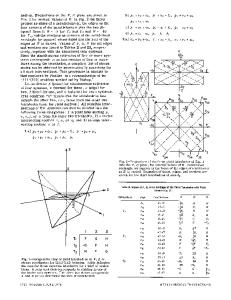Twinning and crystal slip in black monoclinic ZnP 2
- PDF / 633,338 Bytes
- 9 Pages / 595.44 x 841.68 pts Page_size
- 15 Downloads / 374 Views
I. INTRODUCTION Many processing steps in advanced semiconductor device fabrication are carried out in the presence of interfaces. These processing steps consist of controlled doping, annealing of ion-implantation induced defects, oxidation, and silicide formation. During these hightemperature processing steps, dopants, impurities, selfinterstitials, and vacancies migrate to cluster or take part in other diffusional processes. The diffusional processes associated with defects and impurities control dopant profiles in semiconductor devices and development of microstructures that determine the physical properties of these materials.1'2 The presence of interfaces represents sources of local stress, which affect elastic strain energy and forces on point defects. The interaction forces between point defects and interfaces affect the formation and migration energies of these defects. As a result, changes in dopant profiles and clustering of these defects into dislocation microstructures are critically influenced by the presence of interfaces. During oxidation of doped silicon, the dopant interaction forces with an Si-SiO2 interface has been shown to change the dopant distribution profiles.3 In order to determine the nature of these effects, the strain energy associated with either an oversize or an undersize atom in the presence of an interface separating two phases with different elastic properties is analyzed. While the elastic interaction of the point defect with the interface is not the only effect that need be considered, it is useful to determine its significance and its importance relative to other interactions, such as electrostatic interaction of the defect with other atoms. In this paper we present a simple, direct, and fundamental approach for determining the elastic field quantities associated with any type of defect in a three-dimensional two-phase medium. The use of surface dislocation distributions at the interface in both the phases avoids the determination, by trial and error, of J. Mater. Res. 1 (1), Jan/Feb 1986
http://journals.cambridge.org
suitable nuclei of strain4 that need to be superimposed in order to satisfy the continuity equations at the interface. Similarly, this procedure does not need any prior determination of Green's functions associated with a point force5 or with an infinitesimal dislocation loop6 to satisfy the continuity equations. The results of the present approach are found to agree with those of the previous work.4 The purpose of the calculations presented in this paper also is to show how, in general, the strain energy associated with any defect in a two-phase medium can be determined from the work done by the tractions at the interface. Thus the present calculations illustrate the general method of determining the strain energy of a point source in a two-phase medium. This method, without any limitation, also can be applied to other types of defects as well. The determination of strain energy in an analytical form enables incorporation of the results into the solution of the d
Data Loading...











